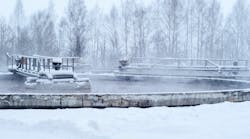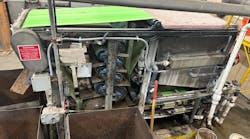The rainy
winter months in Forest City, North Carolina, posed a major challenge for the
city’s wastewater treatment plant. In addition to treating wastewater, the city
also recycled and stored biosolids — a byproduct of the wastewater treatment
process.
After
treating the biosolids, the city worked with a local contractor to haul the
material to neighboring farms where it was spread on pastures and used as
fertilizer at no cost to the farmers. However, during the rainy season the
material could not be shipped away and the city was forced to store the
biosolids for weeks on end.
The city
had limited space to hold the material for extended periods of time. To make
matters worse, at times the fecal coliform counts found in the biosolids
continued to increase the longer the material was stored, exceeding the limits
set by the U.S. Environmental Protection Agency for Class B biosolids.
Faced with
limited storage space and a biosolids product that might not meet Class B
certification, the city needed an alternative method to produce and store its
biosolids.
In May
1997, Forest City turned to USFilter to help eliminate its biosolids storage
problem. USFilter supplied the city with its Dragon Dryer™ Indirect Rotating
Chamber (IRC) — an automated heat drying system that produces Class A
biosolids. The Dragon Dryer, engineered by USFilter’s Davis Products of
Thomasville, Georgia, safely dries biosolids and decreases the volume they
occupy by 75 percent or more.
In the past
decade, heat drying has become widely used because it minimizes the sheer
volume of biosolids, eliminates harmful bacteria, and produces a higher quality
product.
Previously,
Forest City strove to produce Class B biosolids, which have less stringent
standards for treatment and contain various amounts of pathogens. The pathogens
found in Class B material are generally reduced and diluted once the material
is spread and exposed to natural sunlight, wind and soil microbes. For the city
to achieve Class A biosolids certification, it would have to incorporate
treatment that included either heating or composting to remove bacteria from
the biosolids to legislative limits before the material left the facility.
Since the
Dragon Dryer operates at temperatures at or near 212 degrees Fahrenheit, the
high heat kills pathogens found in the biosolids during the drying process.
Consequently, the Dragon Dryer produces only Class A biosolids, which meet and
exceed the EPA’s standards for pathogen free material and vector attraction.
The
single-pass dryer produces biosolids in granule sizes perfect for use as a
fertilizer and capable of being stored in the facility’s 6,000 cubic foot
storage silo. Having found such a comparable solution to its biosolids
problems, the Forest City wastewater treatment plant was well on its way to
becoming a more efficient facility.
Prior to
installation of the dryer, the city was storing its biosolids in roll-off
containers all over its property. Today, the city can safely store 30 days
worth of processed biosolids in one silo for up to four weeks without removal.
The Dragon Dryer has the capacity to dry up to 50 wet tons of biosolids per 24
hours.
With the
Dragon Dryer, the facility now is producing Class A biosolids, enabling the
city to distribute the material for use as a fertilizer for agriculture and
residential lawns or gardens. The system was designed so farmers can drive to
the plant, place their truck under the silo, and load the dried biosolids for a
$20 fee. Prior to the installation of the system, the plant had to hire
contractors to deliver the wet biosolids during the fair weather days of
winter, which were few and far between.
The
stand-alone Dragon Dryer system comes ready to use. Once installed, wet
biosolids are conveyed to the dryer and enter a rotating dehydration tube. The
tube is heated on the outside by three natural-gas-fired burners — never
putting the material in direct contact with the heat source. The
counter-current rotation of the internal auger versus the external tube creates
extra agitation of the material and ultimately more efficient heat drying.
While the
biosolids pass through the drying stage, temperatures reach 212 degrees
Fahrenheit for a retention time of approximately 2-3 hours. These temperatures
quickly kill pathogens in the biosolids. The retention time exceeds the
requirement for vector attraction reduction. Finally, the dried biosolids
emerge in the silo in the shape of 1 to 4 mm pellets.
The system
is environmentally safe, isolating the drying chamber from combustion gases to
minimize air emissions, while clean-burning, high-efficiency gas burners meet
all federal and state air-quality regulations.

